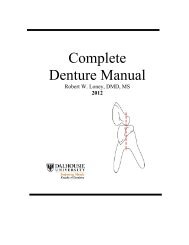RPD Manual 11 - Removable Prosthodontics - Dalhousie University
RPD Manual 11 - Removable Prosthodontics - Dalhousie University
RPD Manual 11 - Removable Prosthodontics - Dalhousie University
Create successful ePaper yourself
Turn your PDF publications into a flip-book with our unique Google optimized e-Paper software.
Direct and Indirect Retainers - 48<br />
4. "C" clasp (Hair-pin or Reverse action)<br />
a. The retentive area (undercut) is adjacent the<br />
occlusal rest.<br />
b. The upper arm is a minor a connector giving<br />
rise to tapered lower arm.<br />
Advantages:<br />
a. Allows use of undercut adjacent to edentulous space<br />
Disadvantages:<br />
a. Almost impossible to adjust<br />
b. Non-esthetic<br />
c. Difficult to fabricate so the upper portion of the retentive arm clears the opposing<br />
occlusion<br />
d. Covers extensive tooth surface and acts as a food trap<br />
e. Insufficient flexibility on short crowns due to insufficient clasp arm length<br />
Cast suprabulge clasps should be used in most tooth borne cases. Exceptions to this rule include:<br />
1. Esthetic concerns. Since wrought-wire clasps can be placed into greater undercuts<br />
(0.02") than cast clasps (0.01") they can be placed lower on teeth, allowing better<br />
esthetics in some cases. Infrabulge clasps are also less visible.<br />
2. Where a posterior abutment is mobile or of questionable prognosis, the treatment<br />
plan could call for the use of the stress-breaking qualities of a wrought clasp on the<br />
anterior abutment. This would allow the prosthesis to be converted into a distal<br />
extension type if the weak posterior abutment should be lost.<br />
3. Where abutments are mobile, the tooth borne segment is extensive, the use of the<br />
stress-breaking clasps should be considered.<br />
Disadvantages of cast suprabulge clasps:<br />
1. Create a "pump-handle" action on the abutment teeth in distal extension cases if the<br />
guiding plane on the distal surface is too long, with insufficient relief.<br />
2. Some clasps can be ineffective on teeth tilted buccally or lingually<br />
3. Some varieties cover more tooth surface than is desirable<br />
4. Poor esthetics in the anterior region<br />
There have been many modifications to cast suprabulge clasps. Some are too complex and<br />
impractical for common use.















